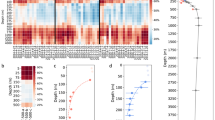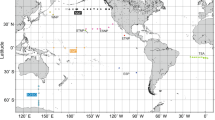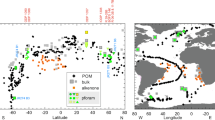Abstract
Particulate organic matter (POM) has a central role in the vertical transport of material in the sea1. In the open ocean, POM is produced in the euphotic layer by phytoplankton and degraded in the aphotic layer during sinking to the sea floor. Isotopic abundance of biophilic elements such as C and N in POM is altered by isotopic fractionations associated with biochemical reactions2. Natural abundances of 13C or 15N thus provide useful information on biochemical behaviour of POM in the sea. We report here the first comprehensive data on the vertical distribution of 15N in suspended POM3 collected at a station in the northeastern Indian Ocean. Also, we discuss how nitrogen isotopic analysis could be used for the identification and quantification of the vertical transport processes.
This is a preview of subscription content, access via your institution
Access options
Subscribe to this journal
Receive 51 print issues and online access
$199.00 per year
only $3.90 per issue
Buy this article
- Purchase on Springer Link
- Instant access to full article PDF
Prices may be subject to local taxes which are calculated during checkout
Similar content being viewed by others
References
Lal, D. Science 198, 997–1009 (1977).
Parker, P. L. & Calder, J. A. in Organic Matter in Natural Waters (ed. Hood, D. W.) 107–127 (Institute of Marine Science, University of Alaska, 1970).
McCave, I. N. Deep-Sea Res. 22, 491–502 (1975).
Williams, P. M. & Gordon, L. I. Deep-Sea Res. 17, 19–27 (1970).
Eadie, B. J. & Jeffrey, L. M. Mar. Chem. 1, 199–209 (1973).
Gordon, D. C. Jr Deep-Sea Res. 24, 257–270 (1977).
Taga, N. (ed.) Preliminary Report of the Hakuko Maru Cruise KH-76-5 (Ocean Research Institute, University of Tokyo, in the press).
Wada, E., Tsuji, T., Saino, T. & Hattori, A. Analyt. Biochem. 80, 312–318 (1977).
Redfield, A. C., Ketchum, B. H. & Richards, F. A. in The Sea Vol. 2 (ed. Hill, M. N.) 26–77 (Interscience, New York, 1963).
Wada, E., Kadonaga, T. & Matsuo, S. Geochem. J. 9, 139–148 (1975).
Wada, E. in Isotope Marine Chemistry (eds Goldberg, E. D. & Horibe, Y.) (Uchida-Rokakuho, Tokyo, in the press).
Goering, J. J., Wallen, D. D. & Nauman, R. M. Limnol. Oceanogr. 15, 789–796 (1970).
Wada, E. & Hattori, A. Geomicrobiol. J. 1, 85–101 (1978).
Cline, J. D. & Kaplan, I. R. Mar. Chem. 3, 271–299 (1975).
Saino, T. thesis, Univ. Tokyo (1977).
Wada, E. & Hattori, A. Geochim. cosmochim. Acta 40, 249–251 (1976).
Bishop, J. K. B., Edmond, J. M., Ketten, D. R., Bacon, M. P. & Silker, W. B. Deep-Sea Res. 24, 511–548 (1977).
Wiebe, P. H., Boyd, S. H. & Winget, C. J. mar. Res. 34, 341–354 (1976).
Knauer, G. A., Martin, J. H. & Bluland, K. W. Deep-Sea Res. 26 A, 97–108 (1979).
Peters, K. E., Sweeney, R. E. & Kaplan, I. R. Limnol. Oceanogr. 23, 598–604 (1978).
Author information
Authors and Affiliations
Rights and permissions
About this article
Cite this article
Saino, T., Hattori, A. 15N natural abundance in oceanic suspended particulate matter. Nature 283, 752–754 (1980). https://doi.org/10.1038/283752a0
Received:
Accepted:
Issue Date:
DOI: https://doi.org/10.1038/283752a0
This article is cited by
-
Estimating Photosynthetically Active Euphotic Layer in Major Lakes of Kumaun Region Using Secchi Depth
Water, Air, & Soil Pollution (2023)
-
What is the menu today in a subantarctic kelp food web from the Kerguelen Islands? Phytodetritus, phytoplankton and phytobenthos; not living kelp
Marine Biology (2022)
-
Isotope alteration caused by changes in biochemical composition of sedimentary organic matter
Biogeochemistry (2020)
-
Nitrogen isotopic fractionation of particulate organic matter production and remineralization in the Prydz Bay and its adjacent areas
Acta Oceanologica Sinica (2020)
-
A Review on Marine N2 Fixation: Mechanism, Evolution of Methodologies, Rates, and Future Concerns
Ocean Science Journal (2019)
Comments
By submitting a comment you agree to abide by our Terms and Community Guidelines. If you find something abusive or that does not comply with our terms or guidelines please flag it as inappropriate.



